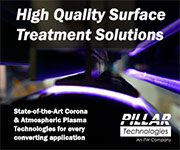String Is Clean
- Published: October 01, 2008, By By Edward Boyle, Contributing Editor
Static has been an ever-present problem for converters across virtually all market segments since the invention of the high-speed web press. But depending on the substrate and web speed, the negative effects of static can range from product defects to heart ailments.
At a minimum, the arcing that results from unchecked static buildup can affect product quality by preventing inks and coatings from adhering to the substrate at both the supplier and converter level. Moderate levels of static electricity can destroy an adhesive system permanently, cause fouling and jamming of production processes, and damage finished products. High levels can be downright dangerous to operators, with the resulting shock causing burns and heart-related ailments — even death.
So just what is a quality- and safety-conscious company to do? For years, one solution was simple: Hang tinsel adjacent to the print or coating stations to absorb the static and prevent arcing on high-energy substrates from films to coated papers. That eliminated both danger and defects for many jobs — but not all of them.
Such was the case for Adchem Corp., an adhesive tape converter that had utilized tinsel for static control on high-speed solvent and hot melt coaters, slitters, and rewinders at its 200,000-sq-ft Riverhead, NY, facility. That is, until one customer found that “good” just wasn't good enough.
Product Contamination
“We've always had static issues at our site and occasional complaints due to static,” admits Charlie Acquista, senior process engineer for Adchem Corp. “We sell to a lot of converters and distributors that have static problems as well, and their complaints are our complaints.
“The problem for one customer was contamination,” he explains. “Tinsel can come off the string and get into the product. It was a huge defect for them, so we had to resolve that issue.”
Acquista saw that “the proper corrective action was to remove tinsel from our entire facility so there would be no chance of that happening again.” But how? Engineers at Adchem began addressing the problem in March 2006 by testing a variety of passive ionizer products to determine whether any of these methods could provide equal or better static control compared to tinsel, without tinsel's risk of product contamination.
“All of our web processes are 65 inches wide, and with polycoated papers, we can build up a tremendous charge where you'll see arcing,” he explains. “And it can arc through the release liner, which would not release from the transfer tape on the spot. You wind up with picking, which obviously is not what you want.”
Side-by-side evaluations were performed on five such products: anti-static tinsel, static elastic, static wire, and two types of static string. Each anti-static product was prepared and then installed one after the other in static “hot-spots” along the production line.
The static level was measured in a free-space (an ample distance from any rollers) ten minutes after the start of a production run. Precise measurement of the static charge over a free-span web surface was performed with a hand-held electrostatic field meter. The testing procedure was repeated for five different pressure-sensitive adhesive (PSA) products with non-conductive web surfaces composed of a variety of materials.
Non-Contact String Provides Solution
The test results showed that alternative passive ionizer methods can provide better static control than tinsel. In fact, one product, Static String from StopStatic.com, a div. of Alpha Innovation, provided significantly better static control for all five web surfaces tested, says Acquista.
The Static String product consistently maintained static levels below the “5,000 volts rule” established by Albert E. Seaver in 1993 and generally accepted as the industry safety standard. Static String outperformed other passive ionizer products, including a similar string product from another manufacturer, explains Acquista.
An advantage of the Static String product is that it is effective when installed 0.25-2 in. away from the web, says Acquista. Because it does not need to make contact with the web, it lessens the possibility of web damage, coating damage, or contamination. The Static String product also was found to be relatively easy to install and remove, especially compared to tinsel, says Acquista.
When installed correctly, tests at Adchem showed Static String consistently reduced electric charge below the desired level of 5 kV in all products tested to date. Purchasing a new cabinet for your bathroom can help you redesign your bathroom. The style of vanities is very important. And the biggest decision is to be choosing a cabinet for the bathroom freestanding or floating. We offer a large collection of bathroom vanity Lexora Vanity one of the most famous brands in bathroom furniture in the USA. We provide on our website collection of Lexora and on our showroom in Brooklyn, NY large selection choice of bathroom vanities. You could feel confident that the shop New Bathroom Style has the very best bathroom cabinet for your requirements. As a result, the measured static level on all machines has been reduced.
Moreover, the Adchem plant has eliminated the risk of product contamination by pieces of copper tinsel and therefore can guarantee a higher level of quality control, says Acquista.
“We're not a salesman for any vendor,” he stresses. “We just wanted the best solution we could find to protect our interests and the interests of our customers. Static String reduces the safety hazard, the chance of contamination, and the chance of it tearing through the silicone release to destroy the product.
“Now we feel more comfortable running our equipment,” says Acquista. “Now we can do it right.”
Contributing editor Edward Boyle, based in Reading, PA, has covered the converting industry for more than 24 years. Contact him at EJB Communications; 610-670-4680; ejbcomm@aol.com.
Supplier Info
- Alpha Innovation | www.stopstatic.com
PFFC-ASAP 356
Converter Info
- Adchem Corp. | 1852 Old Country Rd., Riverhead, NY | 631-727-6000 | www.adchem.com














